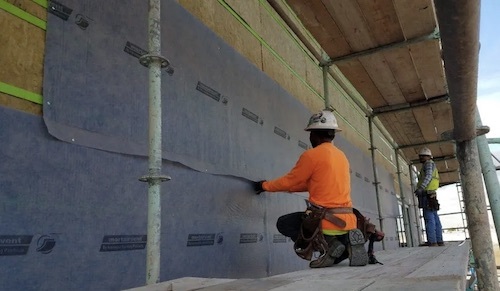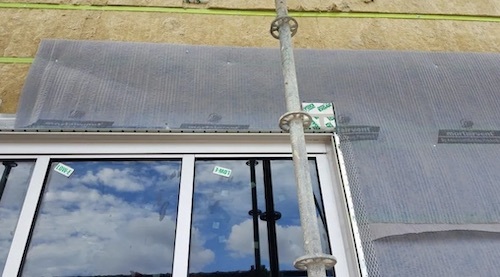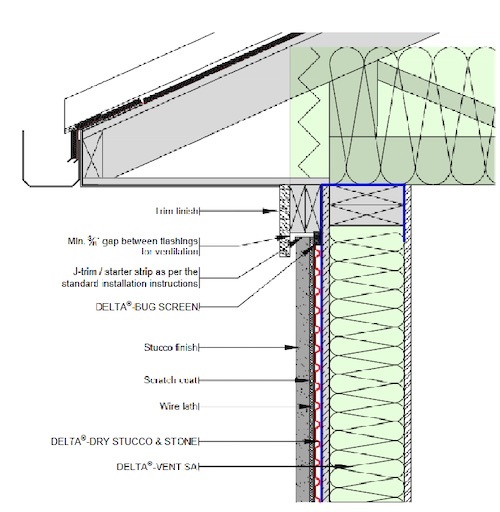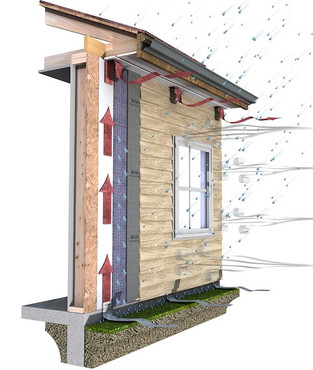Posted by Spycor Building on Mar 21st 2025

When it comes to protecting a home or building from moisture damage, a rainscreen system is one of the most effective solutions. Whether you’re a home builder, contractor, or a DIY enthusiast, understanding the advantages of rainscreen cladding can help you make informed decisions for your next project. In this blog, we’ll explore the key benefits of a rainscreen, its installation process, and why it’s a smart investment for both residential and commercial buildings.
Whether you’re a home builder, contractor, or a DIY enthusiast, understanding the advantages of rainscreen cladding is essential for ensuring long-lasting protection and energy efficiency. Rainscreens not only improve a building’s resilience against harsh weather conditions but also enhance ventilation, reduce maintenance costs, and contribute to improved thermal performance.
A rainscreen is a protective barrier installed behind the exterior cladding of a building. It creates a small air gap that allows for drainage and ventilation, preventing moisture from being trapped within the structure. This system helps extend the life of a building by protecting it from water infiltration, mold, and rot.
By creating a small air gap between the cladding and the building envelope, a rainscreen allows for proper drainage and ventilation, preventing moisture from getting trapped within the structure. Rainscreen systems are widely used in both residential and commercial construction because they not only enhance longevity but also contribute to energy efficiency by improving airflow and reducing thermal bridging. Whether for a new build or a renovation, incorporating a rainscreen is a smart investment that ensures a dry, durable, and well-protected building for years to come.

Key Benefits of Rainscreen Cladding
1. Superior Moisture Management
Moisture is one of the leading causes of structural damage in buildings. A rainscreen system helps prevent water from penetrating exterior walls, allowing it to drain and evaporate before causing issues like mold or wood rot.
2. Enhanced Energy Efficiency
By improving ventilation and reducing thermal bridging, a rainscreen design helps regulate indoor temperatures. This means lower heating and cooling costs, making it a smart investment for homeowners looking to improve energy efficiency.
3. Increased Durability and Longevity
Buildings with rainscreen cladding tend to last longer because they are better protected from environmental damage. Properly installed rainscreen systems for residential buildings can add years to the lifespan of exterior walls.
4. Better Aesthetic Appeal
A rainscreen installation allows for a wide variety of materials, including wood, metal, fiber cement, and composite panels. This means builders and homeowners can achieve their desired look without compromising on performance.
5. Reduced Maintenance Costs
Without a rainscreen system, walls are more susceptible to cracks, mold, and water stains. Investing in a rainscreen design reduces the need for frequent repairs, saving money in the long run.
How to Install a Rainscreen System
Installing a rainscreen system is a crucial step in ensuring long-term moisture protection for your building. Proper installation not only enhances water drainage but also improves ventilation, preventing trapped moisture from causing structural damage. If you're considering adding a rainscreen system to your project, follow these essential steps:
1. Prepare the Surface – Before installation, ensure the exterior sheathing is clean, dry, and free of debris. Any existing damage should be repaired to create a solid foundation for the rainscreen system.
2. Install a Weather-Resistant Barrier – A waterproof house wrap or membrane should be applied over the sheathing. This barrier acts as a secondary defense against moisture, ensuring that any water that gets behind the cladding does not reach the structural wall.
3. Add Furring Strips or a Drainage Mat – To create the necessary air gap, install vertical or horizontal furring strips, or use a dedicated rainscreen drainage mat. This space allows water to drain away and promotes airflow, helping to dry out any trapped moisture.
4. Attach the Cladding – Secure the exterior panels or siding to the furring strips, ensuring there is enough space for air circulation behind the cladding. Different materials, such as fiber cement, wood, metal, or composite panels, may require specific fasteners and installation techniques.
5. Ensure Proper Sealing – Pay close attention to flashing and sealants, especially around windows, doors, and other penetrations. Proper sealing prevents water from seeping into vulnerable areas and helps maintain the integrity of the system.
Choosing the Right Rainscreen Cladding Materials
Selecting the best rainscreen cladding for your building involves more than just aesthetics—it’s about durability, maintenance, and performance in various weather conditions. The right material will enhance your building’s moisture protection, energy efficiency, and overall lifespan, making it a crucial decision for any construction project.
When choosing a rainscreen cladding material, consider key factors such as:
✔️ Climate – Does your area experience heavy rain, snow, or extreme temperatures?
✔️ Budget – Some materials have higher upfront costs but lower long-term maintenance.
✔️ Aesthetics – Cladding significantly impacts your building’s visual appeal.
✔️ Durability & Maintenance – How much upkeep is required to keep the material in top shape?

Rainscreen Cladding Materials Comparison:
Wood – Offers a natural, timeless look but requires regular maintenance such as staining or sealing to protect against moisture and pests. Best for residential projects where aesthetics are a priority.
Fiber Cement – A durable, low-maintenance option that mimics the look of wood, stone, or stucco while offering excellent moisture resistance. Fire-resistant and ideal for both residential and commercial buildings.
Metal Panels – A modern, sleek appearance combined with exceptional durability. Resistant to fire, mold, and pests, metal cladding is ideal for extreme weather conditions but may require proper insulation to prevent condensation.
Composite Panels – A blend of wood fibers, plastics, and resins, these panels are lightweight, weather-resistant, and highly versatile. Available in a range of textures and colors, they offer a balance of aesthetics and performance.
Each cladding option comes with unique advantages, so choosing the right one depends on your specific project needs. Whether you prioritize long-term durability, affordability, or modern aesthetics, selecting the best rainscreen cladding ensures your building stays protected and visually appealing for years to come.
A rainscreen system is one of the best ways to protect a building from moisture damage while improving energy efficiency and durability. Whether you’re working on a new construction project or upgrading an existing structure, investing in rainscreen cladding is a smart choice.
At Spycor Building Products, we offer high-quality rainscreen systems for residential buildings and commercial projects. Explore our selection today and enhance the longevity of your next project!
Ready to Get Started? Browse our selection of rainscreen cladding materials and installation accessories at SpycorBuilding.com!
By creating a small air gap between the cladding and the building envelope, a rainscreen allows for proper drainage and ventilation, preventing moisture from getting trapped within the structure.
CLICK HERE to Learn More!


